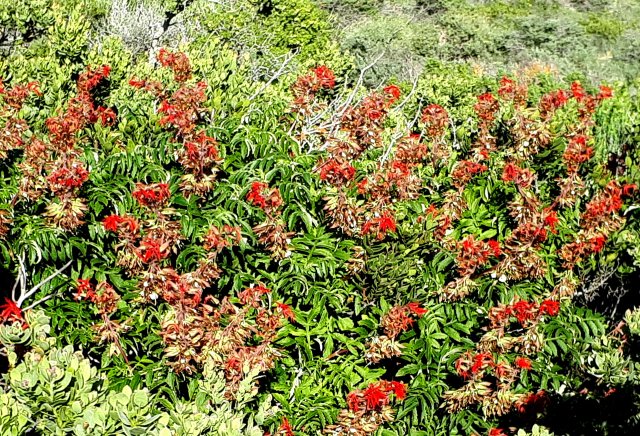Melianthus pectinatus

Author: Ivan Lätti
Photographer: Jack Lätti
Melianthus pectinatus, the Namaqua turkey bush, is a spreading to rounded shrub reaching 2 m in height. It is the showiest of the three Namaqualand Melianthus species.
The leathery leaves are divided into narrow, linear to lance-shaped leaflets. Leafy stipules are present. The leaf becomes up to 19 cm long, the leaflets numbering from 11 to 19. The specific name, pectinatus, is derived from the Latin word pecten, a comb, meaning having narrow parallel projections or divisions suggestive of the teeth of a comb, referring to the rows of leaflets.
The leaflet margins are often toothed or scalloped and rolled under. The deep green to grey-green upper surfaces are hairless and sometimes glossy, the lower ones felted. The midrib is winged. The plant is sometimes summer deciduous.
The leaves exude a pungent odour when touched. Curiosity usually requires a test of this feature; repetition of the action does not happen often. The Afrikaans common name, kruidjie-roer-my-nie, warns: Do not touch me!
The flowers grow terminally in erect racemes of two to four flowers among or above the leaves. The five sepals are dissimilar. The unequal petals start off scarlet in the bud phase, turning brown at anthesis, i.e. when fully open and already appearing withered. The flowers are about 2 cm to 2,5 cm long. Flowering happens from late winter to mid-spring. The photo was taken in August.
The ovary and fruit are hairless, the pod mottled green. The seeds are black.
The species is found in the Richtersveld and the Namaqua Klipkoppe, also in Namibia where it is rare. The plant grows on rocky slopes. It is not considered to be threatened in its habitat early in the twenty first century.
There are two subspecies of M. pectinatus, both in the northwest. A coastal species of Melianthus also occurs in Namaqualand, called M. elongatus (Williamson, 2010; Manning, 2009; Le Roux, et al, 2005; Eliovson, 1990; iNaturalist; http://redlist.sanbi.org).

